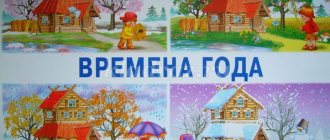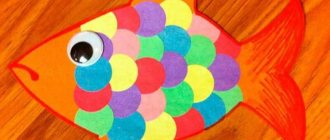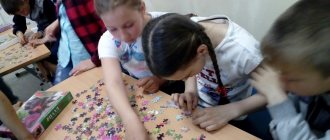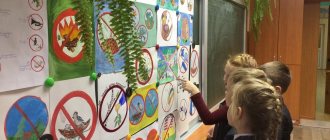Summary of the lesson in the theater studio “The Magic of Rhythm and Plasticity”
Children perform the “pat the cat” pantomime; the teacher notes the children’s successes and asks leading questions.
Teacher:
Great! Now let's release the cat. There is a snake lying in front of you now, pet it.
Next, the teacher suggests petting different animals:
- a rabbit,
- elephant,
- giraffe,
- a hamster.
Teacher:
You guys are great, who wants to share their impressions? What did you like, what was difficult to do? (children's answers)
Teacher:
We continue to develop our plasticity, and now we will try to put all our skill into our hands by doing the “Magic Hands” exercise. Imagine that you are painting a fence, your hand acts as a brush.
Children begin to perform the “Magic Hands” exercise. The teacher notes successful work and corrects the children’s work
A number of tasks are performed:
— we paint the fence: with the right hand, with the left hand, with both hands at once synchronously, with both hands towards each other;
— coordination of movement: with one hand we paint the fence, with the other we draw a “triangle”;
— rowing: on a boat, on a canoe, on a gondola;
— we wash the clothes: soak them with three soaps of soap, rinse them, wring them out and hang them up;
Teacher:
Well done! I was very interested in watching your work. Now it's time to connect the whole body, I suggest doing a little Fire-Ice warm-up. At the signal “fire” you turn into a light, cheerful, fast, bright. At the “ice” signal, you freeze in the position that caught you, while strongly tensing your muscles.
The “Fire-Ice” warm-up is carried out, the teacher monitors the correct execution.
Teacher:
Guys, now I will ask you to divide into pairs (children find a partner). Please agree who will be the leader and who will be the follower. The leader’s task is to make his partner dance, “flowing” from one pose to another.
The teacher uses his example to show how to complete the exercise, then the children begin to work independently, and after time the roles in the pair change. The teacher monitors the correct execution and helps the children.
Teacher:
Great! It was a very interesting dance! Would you like to dance now on your own, rather than being told to do so? (children's answers) Great, then I offer you the following exercise “Dancing Mirror”. I ask you to agree again which of you will be a “mirror” and which one will be a “person”. The task of the “mirror” is to repeat the partner’s dance as accurately as possible, the task of the “person is to come up with a dance in accordance with the music, I ask you to take into account each other’s capabilities.
Performing the “dance mirror” exercise, several melodies of different nature are used.
Teacher:
Thank you guys, it was a pleasure to watch your work. Please sit down in a circle. Please share what was easier for you to do and what was more difficult? (children's answers). Did you notice how much the rhythm of the music differed and how your movements changed based on this rhythm? I would be interested in trying to experiment with the rhythm, what about you? (children's answers) What do you think can set the rhythm? (children's answers) Claps, I think it's a great option! Now I will give you a rhythm, and you try to pick it up, over time I will change it.
Exercises for classes in a theater club card index
Exercises to develop hand plasticity, body movements,
imagination and coordination.
"Stream"
We make wave-like movements with the hand and arm (up to the elbow), as if a stream were flowing; We depict with our hands as if we are splashing water to the sides, then on our face; wipe your face with your hands.
"Swan"
The exercise is performed with one hand, with two hands - we teach you to wave your arms, depicting a swan. Slowly raise your hand up - first comes the elbow, then the hand - fingers, then smoothly lower the hand: elbow - hand - fingers.
"Pantomimic Wall"
Starting position: feet shoulder-width apart, body relaxed. The right arm is bent at the elbow, fingers clenched into a fist. Straighten your fingers sharply, tense your palm. It is explained to the children that the hand seems to be resting against an invisible wall. We walk along an invisible wall, trying to find a way out in the wall, on the ceiling, on the floor. Gradually the room narrows: the ceiling drops, the walls move. The room turns into a small box. Now everything is gradually expanding.
"Orchestra"
We imitate playing various instruments: we “play” the piano, violin, guitar, drum, trumpet, etc. First, take turns playing each instrument, then each participant chooses an instrument for himself. At the end there should be an instrumental ensemble. The game is played to music. Without interruption, children smoothly move from one musical image to another.
"We are drawing"
a) Let's imagine that our brush is a brush. Gently dip the brush into the paint and begin to paint over imaginary walls, ceilings, and floors. Pay attention to the smooth movement of the hand.
b) Draw a picture with colored paints. Be sure to mentally imagine the drawing in color. The game is played to music.
Contact and non-contact improvisation
"Butterfly"
We move around the hall to the music, trying not to hurt anyone, but staying close to each other. On command, participants freeze in various poses, allowing one, two, four, six butterflies to be placed on themselves. For example, place the elbow of your right hand and the heel of your left foot - “places” for butterflies.
Pair exercises
"Rostock"
Goal: interaction with a partner.
Participants - plant grains - are distributed in pairs. The grains begin to germinate, branches, roots, etc. appear. The grains begin to “wrap” each other without touching the partner.
"Mirror"
Participants are divided into pairs. One of the partners is a mirror. The task of the mirror is to accurately copy and repeat the movements of the partner, being his reflection. Then the players change places.
"Sweets - tray"
A couple holds an imaginary tray of sweets. The couple's task is to carry the tray without dropping it and the sweets through rivers, mountains, holes and other obstacles.
"Wall"
In a position of stability - contact improvisation to trust a partner, the ability to distribute weight. Focus on your partner's palms. Let's hold each other.
"3 expenses"
The first is to “slide”: partners rest their foreheads on each other, evenly distributing their weight so as not to fall. The task is to slide your foreheads past each other and run in the opposite direction. The same thing, but emphasis on the shoulder, arms, hip, back, etc.
The second is to “melt”: the emphasis is the same as in the first. On command, the partners begin to melt, sinking to the floor.
The third is to “tear off sharply”: the contacts are the same. On command, the partners abruptly break away from each other and rush to opposite corners of the room.
LESSON STRUCTURE:
- Greetings and game exercises for attention and observation.
- Speech technique exercises.
- Tasks on plastic movements.
- Outdoor games.
Each lesson should contain some new element, exercise, task or game.
Hello kids, girls and boys!
Let's get to know you!
My name is Nonna Vladimirovna!
(I get to know the students in a playful way - I throw the ball, they throw the ball back to me, saying their name, or pass the ball to each other, also saying their name)
Guys, show me your five fingers:
Each finger greets the thumb and says “Hello” to it.
First slowly, then faster (3-5 times).
Now we will do an exercise, pronouncing the following text:
Finger on finger - knock, knock, knock!
Palm on palm - clap, clap, clap! Foot on the floor - top, top, top!
Now clench your hands into fists.
When naming a finger, we bend each finger simultaneously on both hands:
My little finger, where have you been?
— With the nameless one, I cooked cabbage soup.
And with average - I ate porridge.
And the big one met me
And he treated me to candy.
Today we will begin a long journey into the world of theater. Do you know who invented THEATER?
Theater was invented by the ancient Greeks and theater means SPECTRUM, people portrayed different heroes: bad and good, evil and kind, cheerful and sad.
Guys? What fairy-tale characters do you know? (there is a dialogue with the children).
Theater is magic! He can do everything.
We can go wherever we want.
Let's stand in a circle.
Using educational games and exercises in theater classes
Experience as an additional education teacher.
Using educational games and exercises in theater classes Playing is a favorite activity for children. While playing, the child opens up, liberates, becomes free and cheerful. Everyone knows that theater is a collective art, and initially my first task, in the first year of study, was to unite a friendly creative team. When they first come to class, the children experience great difficulties in communicating: they are embarrassed by the teacher, each other, are afraid to go on stage when they see an audience, and cannot speak loudly and clearly. And to help the children in my classes, I use educational theater games. Play, as a special form of communication in the process of theatrical activity, is a set of specially selected tasks and exercises aimed at developing the basic psychological processes in children: (attention, memory, imagination, speech), which are fundamental components of acting. The methods, forms and content of theatrical games and trainings that I offer to children simultaneously realize three goals: - immerse children in the inherent atmosphere of the game; - develop memory, attention, imagination, fantasy, creative thinking; - impart to the educational process the qualities of interesting, exciting and fun work necessary for children. The main requirements that I adhere to in organizing games: - Content and variety of themes of games in the classroom. — Maximum activity of children at the stages of preparation and conduct of games. — Cooperation of children with each other and with adults at all stages of organizing games. — Constant, daily inclusion of games in all forms of the pedagogical process. -Consistency and gradual complication of the content of themes and plots selected for games that are appropriate to the age and skill of the children. After analyzing my gaming activities in the classroom, I compiled a list of games, exercises and trainings that I use at this stage of my teaching activity. These are educational games and exercises that include: •Game exercises to develop imagination and fantasy; •Stage attention and memory; •Speech exercises; •Sketches; •Game exercises for team building; • Dramatization games.
Game exercises to develop imagination and fantasy Imagination is the ability to mentally create new ideas and images of possible and impossible objects based on real knowledge. Fantasy is the creation of also new, but unrealistic, fabulous, yet impossible situations and objects, but also based on real knowledge. Goal: development of creative imagination, thinking and fantasy. In such exercises, children can work collectively, in groups or in pairs. "The Sculptor and the Clay." Participants are divided into pairs. One of them is a sculptor, the other is clay. The sculptor must give the clay the shape (pose) he wants. “Clay” is pliable, relaxed, “accepts” the shape that the sculptor gives it. The finished sculpture freezes. The sculptor gives it a name. Then “sculptor” and “clay” switch places. Participants are not allowed to talk.
"Magic wand". The exercise is carried out in groups. Requirements for the exercise: I see as given, I treat as given. In this exercise, the guys take turns justifying objects (a pencil - what could it be? - a worm, a thermometer, a conductor's baton, a microphone). "Fairy tale". Exercises are performed in groups or in pairs. Everyone chooses a fairy tale for themselves (at the beginning of the lesson we determine which way we will work - sculpting or drawing), and as a result, the children demonstrate their work and tell their invented fairy tale based on the illustrations. The teacher can complicate the task and ask the children to role-play the plot of the fairy tale they have chosen. "Living Picture". Each participant is both a sculptor and a clay artist. It finds its place in accordance with the general atmosphere and content of the composition. All work takes place in complete silence. The first participant comes out to the center of the room, it can be anyone who wants or is nominated by me, and takes some kind of pose. Then a second one is added to it, the third is added to the composition common to the first two participants. When performing this exercise, you must: 1) act at a fairly fast pace; 2) make sure that the resulting compositions are not a meaningless mosaic of figures isolated from each other.
Stage attention and memory Goal: development of voluntary and non-voluntary attention, development of auditory and visual memory. "Mirror". Participants are divided into pairs and face each other. One of the players makes slow movements. The other must exactly copy all the movements of his partner, be his “mirror image”. At the beginning of the task, the presenter imposes some restrictions on the actions of the “original”.
"Detectives". Each participant performs some physical action while simultaneously quietly observing one of the other participants in the game. After 1-2 minutes, I suggest guessing who was watching whom. Observers must list the actions that their “suspect” performed in the “Object Exercise.” Several objects are randomly laid out on the table (this could be a pencil, a kickball, a notebook, a watch, a coin, glue, a pen, a ruler, etc.). The player looks carefully at the table for 10–15 seconds, then turns away. The presenter at this time replaces 1 item with another, and swaps 2 items. The player's task is to return all objects to their places. "Piano". Students sit next to each other and put their hands on each other’s knees; the task is to remember the sequence of movements, adhere to the tempo and rhythm of the game.
There are a lot of such games, trainings and exercises. I try to pick something new for every lesson. I pay special attention to speech games. Very often, children of primary school age encounter speech impediments such as: “swallowing” or “eating” the end of a word, slurred speech, unclearness. Causes of slurred speech: motionless, limp lips, poorly opened mouth. To get rid of these shortcomings, I perform the following exercises with children: articulatory gymnastics, which allows them to develop the diction apparatus (lips, tongue and jaw).
A good result in stage speech is achieved by using pure tongue twisters and tongue twisters. Pure twisters are the same tongue twisters, but they draw attention not to the speed of pronunciation, but to the purity of pronunciation. I use logical play on tongue twisters. Assignment: say a tongue twister: From the clatter of hooves, dust flies across the field. Requirements for the exercise: - Say with joy, - with reproach, - with chagrin, - with mockery, - in confidence. I also use game exercises to develop speech in motion; previously learned tongue twisters are taken as a basis and a selection of different, not complex movements for them, which are performed together. Training speech in motion develops the ability to combine speech and body movements into a single stage action, which can occur in the same, different, or changing tempo-rhythms during the action. Gesticulation, plasticity, facial expressions in a speech game turn it into a theatrical scene, allowing children to improvise and reveal their creative and acting potential.
Team building games. Positive relationships between children are the key to success and communicative behavior in the future, because it is so important to teach children to play together, and not next to each other. I use most often are competition games. The purpose of such games: -Develop a sense of self-worth and self-respect. -Teach children to overcome isolation and passivity. -To develop the ability to design one’s actions by entering into a community with other children, to coordinate one’s actions with them, to offer one’s help, to follow the rules, and to cooperate in joint activities.
Dramatization game. In dramatization games, the child artist independently creates an image using a set of expressive means (intonation, facial expressions, pantomime), performs his own actions in playing the role... In a dramatization game, the child performs a plot, the script of which exists in advance, but is not rigid a canon, but serves as a framework within which improvisation develops. Improvisation can concern not only text, but also stage action. Types of dramatization: games imitating images of animals, people, literary characters; role-playing dialogues based on text; staging of works; staging performances based on one or more works; Improvisation games where the plot is played out without prior preparation. Dramatizations are based on the actions of a performer, who may use puppets.
Sketches. In my acting classes, it is important for me to teach children the ability to act authentically in fictitious circumstances: To teach children to act in the proposed circumstances. I use developmental exercises - sketches (a sketch is an episode with its own little story) For example: create a living picture (dining room, park, recess, stadium, etc.) Each performer determines for himself who he is in this situation? What can he do? This is where an important quality comes into play: improvisation. In theatrical art this is necessary for the performer. Such exercises develop children’s logic of thinking, attention, imagination, and the main aspect is collective creative activity. The content of the sketches is very diverse: single, pair, group. All fictitious situations should be familiar to the children, based on their life experience. It is important that they believe in what they are doing on stage. In their sketches, children show everything conditionally, the objects are all imaginary. To demonstrate reliably, we do exercises: actions with imaginary objects. Example: Candy (taking into account volume, weight) or a book (old, new, heavy, light), first I give the children real objects so that they hold, look from all sides, and twirl in their hands. After the children have become familiar with the subject, they show it conditionally.
I always try to reinforce theoretical material with practical ones. Creative display is the most expressive and accessible form. I try to involve children in performances from the first day of classes. These are thematic theatrical holidays: autumn festival, New Year's party, environmental scenes, fairy tales. Children do not immediately master the ability to properly hold themselves in a role. To help them reveal their capabilities, long-term special systematic training in exercise games is needed. Creative activity helps children develop memory and a sense of responsibility to the team.
Over the years of work, I have come to the conclusion that if you conduct theatrical games and exercises with children more often, the lesson will not only be very interesting and varied, but in the future it will be much easier for them to work on the stage image in the play, since with the help of games and exercises and trainings, children acquire basic acting skills.
We recommend watching:
How to prepare a child's hands for writing Educational games for children 3 years old Educational game for children 5-8 years old Fun games for developing attention in children from 3 years old
Similar articles:
Educational games in pictures for children 4-5 years old
Educational games for children from 5 to 8 years old
Master class “Use of educational games and creative tasks in Russian language and literature lessons”
Competition for teachers for the best methodological development
Educational game for children 5-7 years old “The World Around Us”









